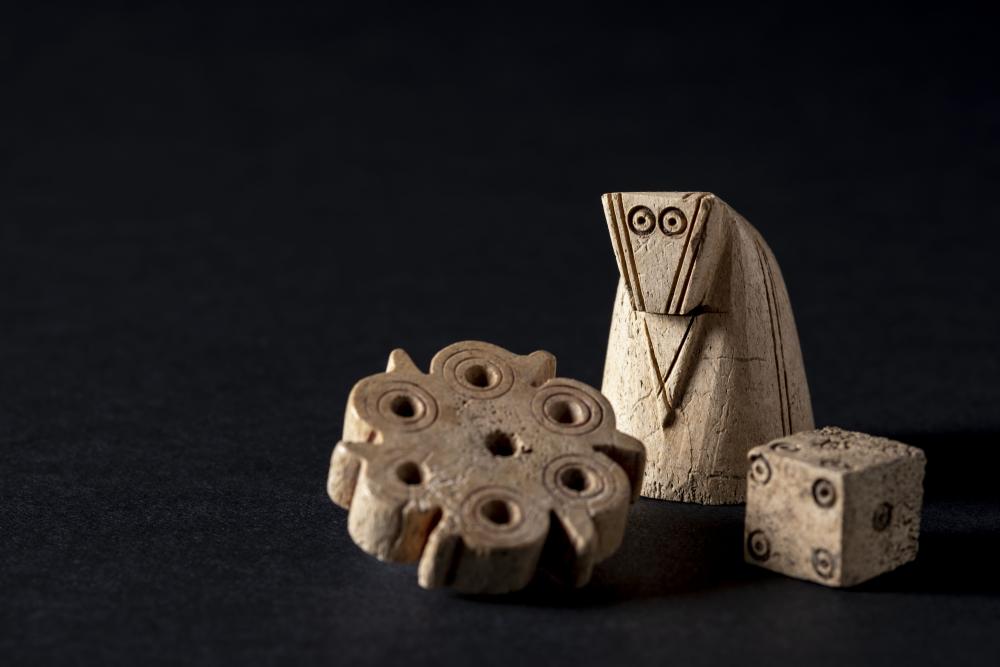Press Releases Archive
03.06.2024
Medieval game collection unearthed
Archaeologists find rare chess piece at a castle in Southern Germany
A team of archaeologists discovers an almost 1.000-year-old games collection including a well-preserved chessman, gaming pieces and dice. Laboratory analyses show that one party played with red. The laboratory results also allow conclusions to be drawn about the astonishing continuity of the rules of the game. The detailed analysis of the finds promises insights into the gaming world of the medieval nobility and the origins of the European game of chess. The finds will be on display for the first time from June 2024.
Over 1000 years ago, the game of chess found its way from the Orient to Europe. Chess pieces from the early days of the game are very rare. During archaeological excavations at a forgotten castle in southern Germany, an excellently preserved knight piece has now been discovered. The find is part of a unique games collection, which also includes other gaming pieces and a dice. An international team of experts from the University of Tübingen, the State Office for the Preservation of Monuments Baden-Württemberg (LAD) and the German Archaeological Institute (DAI) is now examining this evidence of early gaming culture. Laboratory analyses of color residues show that one of the parties played with red. Typical use wear traces indicate that the knight was lifted as it is today during a move, pointing to an astonishing continuity in the rules of the game.
Well-preserved archaeological finds of chess pieces and game pieces for other board games from before the 13th century are very rare in Central Europe. "In the Middle Ages, chess was one of the seven skills that a good knight should master. It is therefore not surprising that known finds mostly come from castles," explained Dr Jonathan Scheschkewitz (LAD). "The discovery of an entire games collection the 11th/12th century came as a complete surprise to us, and the horse-shaped knight piece is a real highlight," said Dr Lukas Werther (DAI).
The finds were discovered during excavations by the DFG Collaborative Research Centre 1070 Resource Cultures and the LAD in a previously unknown castle in southern Germany (Baden-Württemberg, Reutlingen district). "They were lying under the debris of a wall where they were lost or hidden in the Middle Ages," said Dr Michael Kienzle (University of Tübingen). This covering contributed to the exceptionally good surface preservation of the artefacts. "Under the microscope, a typical sheen from holding and moving the pieces can be seen," explained Dr Flavia Venditti (University of Tübingen). In addition to the chess piece, four flower-shaped game pieces were found, as well as a dice with six eyes. They were carved from antlers.
The eyes and mane of the 4 cm high horse figure are vividly shaped. This elaborate design is typical of particularly high-quality chess pieces from this period. The red paint residues found on the flower-shaped pieces are currently being chemically analyzed. By analyzing the finds in detail, the researchers hope to gain a variety of insights into the gaming world of the medieval nobility and the roots of European chess.
The finds will be presented to the interested public for the first time in 2024 in the large national exhibition „THE hidden LÄND“ (Stuttgart, from 13 September 2024, Link) and in the special exhibition „Ausgegraben! Ritter und Burgen im Echaztal / Excavated! Knights and Castles in the Echaz Valley“ (Pfullingen, from 15 June 2024, Link). A 3D model of the chess piece, the dice and the gaming piece is already available online.
Weblinks:
https://uni-tuebingen.de/forschung/forschungsschwerpunkte/sonderforschungsbereiche/sfb-1070/forschung/b-bewegungen/b03/
https://www.dainst.org/forschung/projekte/ressourcenerschliessung-und-herrschaftsraeume-im-mittelalter-kloester-und-burgen/5791
https://greifenstein-projekt.de/ausgegraben/
https://www.alm-konstanz.de/sonderausstellungen/the-hidden-laend-wir-im-ersten-jahrtausend
https://skfb.ly/oTxGo
https://skfb.ly/oTxG8
https://skfb.ly/oTxGt
Press release of the German Archaeological Institute, the State Office for the Preservation of Monuments Baden-Württemberg and the University of Tübingen
Contact:
Dr. Michael Kienzle
University of Tübingen
DFG Collaborative Research Center 1070 ResourceCultures
Burgsteige 11
D-72070 Tübingen
michael.kienzlespam prevention@uni-tuebingen.de
Dr. Jonathan Scheschkewitz
State Office for the Preservation of Monuments Baden-Württemberg
Landesamt für Denkmalpflege im Regierungspräsidium Stuttgart
Ref. 84.2 Regionale Denkmalpflege, Schwerpunkte, Inventarisation
Berliner Straße 12
D-73728 Esslingen am Neckar
+49 711 90445142
Jonathan.Scheschkewitzspam prevention@rps.bwl.de
Press contact Regierungspräsidium Stuttgart
Stefanie Paprotka
+49 711 90410002
pressestellespam prevention@rps.bwl.de
Press contact University of Tübingen
Antje Karbe
+49 7071 29-76789
pressespam prevention@uni-tuebingen.de
Dr. Flavia Venditti
University of Tübingen
Early Prehistory & Quaternary Ecology
Burgsteige 11
D-72070 Tübingen
flavia.vendittispam prevention@uni-tuebingen.de
PD Dr. Lukas Werther
German Archaeological Institute (DAI)
Römisch-Germanische Kommission des Deutschen Archäologischen Institut
Palmengartenstr. 10-12
D-60325 Frankfurt/Main
0049-69-975818-18/-26 (Sekretariat)
lukas.wertherspam prevention@dainst.de
Press contact German Archaeological Institute (DAI)
Sebastian Dobberstein
+49 30 187711-130
pressespam prevention@dainst.de

